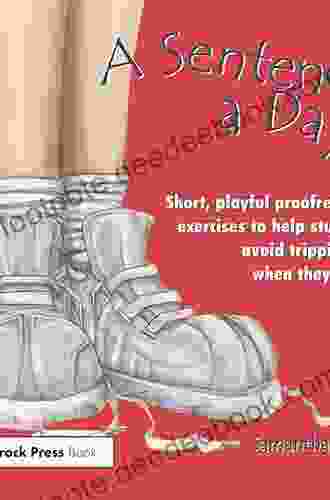Short, Playful Proofreading Exercises to Help Students Conquer Common Writing Mistakes

Proofreading is a crucial skill for students to master. It helps them catch and correct errors in their writing, ensuring that their work is accurate, clear, and polished. However, proofreading can be tedious and time-consuming, and students may find it difficult to stay focused and motivated.
4.6 out of 5
| Language | : | English |
| File size | : | 2780 KB |
| Text-to-Speech | : | Enabled |
| Screen Reader | : | Supported |
| Enhanced typesetting | : | Enabled |
| Word Wise | : | Enabled |
| Print length | : | 209 pages |
| X-Ray for textbooks | : | Enabled |
The good news is that there are a number of short, playful proofreading exercises that you can use to make proofreading more enjoyable and effective for students. These exercises are designed to target common writing mistakes, such as:
- Misspelled words
- Grammar errors
- Punctuation errors
- Word usage errors
- Style errors
By completing these exercises regularly, students can improve their accuracy and avoid tripping up when writing. Here are a few examples of these exercises:
Spot the Mistake
In this exercise, students are given a short passage of text that contains several errors. The students' task is to identify and correct the errors.
For example, you could give students the following passage:
The dog barked at the mailman, who was delivering a letter. The letter was for the dog's owner, who was not home.
Students would then need to identify and correct the following errors:
- "who" should be "that"
- "was" should be "had"
- "was" should be "were"
Find the Missing Word
In this exercise, students are given a short passage of text that has several missing words. The students' task is to fill in the missing words.
For example, you could give students the following passage:
The dog barked at the mailman, ____________ was delivering a letter. The letter was for the dog's owner, ____________ was not home.
Students would then need to fill in the missing words:
- "who"
- "who"
Rewrite the Sentence
In this exercise, students are given a short sentence that contains an error. The students' task is to rewrite the sentence correctly.
For example, you could give students the following sentence:
The dog barked at the mailman, who was delivering a letter.
Students would then need to rewrite the sentence as follows:
The dog barked at the mailman that was delivering a letter.
Proofreading Challenge
In this exercise, students are given a short passage of text that contains several errors. The students' task is to proofread the passage and correct all of the errors.
For example, you could give students the following passage:
The dog barked at the mailman, who was delivering a letter. The letter was for the dog's owner, who was not home. The dog barked at the mailman again, who was now getting impatient.
Students would then need to correct the following errors:
- "who" should be "that"
- "was" should be "had"
- "was" should be "were"
- "who" should be "that"
These are just a few examples of the many short, playful proofreading exercises that you can use to help students improve their accuracy. By completing these exercises regularly, students can develop the skills they need to proofread their own writing effectively and avoid making common writing mistakes.
In addition to these exercises, here are a few tips for helping students improve their proofreading skills:
- Encourage students to read their work aloud. This will help them to hear any errors that they might not see when they are reading silently.
- Have students proofread each other's work. This will give them a chance to see different types of errors and to learn from each other.
- Provide students with feedback on their proofreading. This will help them to identify areas where they need to improve.
- Make proofreading a regular part of your writing instruction. The more students proofread, the better they will become at it.
By following these tips, you can help students develop the strong proofreading skills they need to succeed in school and beyond.
4.6 out of 5
| Language | : | English |
| File size | : | 2780 KB |
| Text-to-Speech | : | Enabled |
| Screen Reader | : | Supported |
| Enhanced typesetting | : | Enabled |
| Word Wise | : | Enabled |
| Print length | : | 209 pages |
| X-Ray for textbooks | : | Enabled |
Do you want to contribute by writing guest posts on this blog?
Please contact us and send us a resume of previous articles that you have written.
 Novel
Novel Page
Page Text
Text Genre
Genre Library
Library Paperback
Paperback Magazine
Magazine Newspaper
Newspaper Paragraph
Paragraph Sentence
Sentence Bookmark
Bookmark Bibliography
Bibliography Foreword
Foreword Preface
Preface Footnote
Footnote Manuscript
Manuscript Scroll
Scroll Autobiography
Autobiography Reference
Reference Encyclopedia
Encyclopedia Thesaurus
Thesaurus Character
Character Resolution
Resolution Catalog
Catalog Borrowing
Borrowing Stacks
Stacks Periodicals
Periodicals Research
Research Scholarly
Scholarly Lending
Lending Reserve
Reserve Reading Room
Reading Room Rare Books
Rare Books Literacy
Literacy Dissertation
Dissertation Storytelling
Storytelling Awards
Awards Reading List
Reading List Book Club
Book Club Theory
Theory Graham Blackburn
Graham Blackburn John Siddique
John Siddique Joice Berth
Joice Berth Stacy Thompson
Stacy Thompson Peter Aleshire
Peter Aleshire Marie James
Marie James Laurence Juber
Laurence Juber Philip Wylie
Philip Wylie The Brotherhood Of Moses
The Brotherhood Of Moses John Miers
John Miers Martin Gilens
Martin Gilens Charles Tambou
Charles Tambou Randy Judd
Randy Judd Dennis R Harrison
Dennis R Harrison Jeff Zwiers
Jeff Zwiers Geoff Tennant
Geoff Tennant William Black
William Black Xist Publishing
Xist Publishing Brigitte Boussuat
Brigitte Boussuat Irina Nevzlin
Irina Nevzlin
Light bulbAdvertise smarter! Our strategic ad space ensures maximum exposure. Reserve your spot today!

 Mario Vargas LlosaMother Goose: The Enduring Charm of Classic Nursery Rhymes, Illustrated by...
Mario Vargas LlosaMother Goose: The Enduring Charm of Classic Nursery Rhymes, Illustrated by...
 Jamal BlairDevising Institutions to Manage the Maine Lobster Industry: A Comprehensive...
Jamal BlairDevising Institutions to Manage the Maine Lobster Industry: A Comprehensive... Russell MitchellFollow ·11.4k
Russell MitchellFollow ·11.4k Alex ReedFollow ·13.2k
Alex ReedFollow ·13.2k Elton HayesFollow ·12.1k
Elton HayesFollow ·12.1k Roland HayesFollow ·13k
Roland HayesFollow ·13k Anthony WellsFollow ·6.3k
Anthony WellsFollow ·6.3k Josh CarterFollow ·5.4k
Josh CarterFollow ·5.4k Miguel NelsonFollow ·2.5k
Miguel NelsonFollow ·2.5k William FaulknerFollow ·2.4k
William FaulknerFollow ·2.4k

 Allen Ginsberg
Allen GinsbergUnveiling the True Meaning of Enough: A Comprehensive...
: In the relentless pursuit of progress and...

 Clay Powell
Clay PowellHawker Hunter: The Jet Fighter that Shaped British...
Nestled in the halls of aviation...

 Alec Hayes
Alec HayesWhen and How to Use Lean Tools and Climb the Four Steps...
Lean is a management...

 Trevor Bell
Trevor BellVolume of Charlotte Mason Original Homeschooling: A...
Charlotte Mason's original...

 John Parker
John ParkerAscending Tristan da Cunha: A Comprehensive Guide to...
Prepare yourself for an extraordinary journey...
4.6 out of 5
| Language | : | English |
| File size | : | 2780 KB |
| Text-to-Speech | : | Enabled |
| Screen Reader | : | Supported |
| Enhanced typesetting | : | Enabled |
| Word Wise | : | Enabled |
| Print length | : | 209 pages |
| X-Ray for textbooks | : | Enabled |










